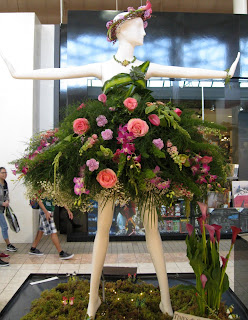The lawn mower is broken. The grass alongside the road is getting long. The blackberry is getting out of control.
I spent a couple of hours cutting back the blackberry that was reaching into Walter's Gorge threatening to cover the beautiful flowers growing there. Himalayan blackberry (Rubus armeniacus) is classed as an invasive species here in BC and it does invade at our place.
Japanese Water Iris (Iris ensata)
Two years ago after Ron and I had cleared the blackberry jungle out of the seasonal stream that flows into the pond, it sat bare until my sister and brother-in-law came to stay. Sister Donnel, who knows a lot about plants (as does my other sister Megan Rae) looked at the site and pronounced "Japanese water irises and ferns." Brother-in-law Walter did the back breaking work digging up and transferring large ferns to the sides of the stream.
We, plus our mother (a phenomenal gardener) went shopping/hunting for the exotic sounding plant and found 2 varieties.
This is the second year of flowers and they get larger each year. They are obviously very happy with the conditions - soil continually moist to flooded depending on the season, acidic soil/water - runoff from the forest up the hill, shade.
I'll have to ask my sister when I should divide the plants up to keep the flowers large.
Horsetail (Equisetum arvense) - behind the iris - has also flourished. The seeds of this ancient plant were waiting deep in the soil for the right conditions.
It is a most unusual plant as well as being one of the oldest on the planet. During the Carboniferous dinosaur age, horsetail grew a hundred feet tall. The Romans called it "hair of the earth."
The hollow stems with 'bad-hair-day' fronds are 30 plus percent silica and a valuable source of the mineral for other plants. Steeping the plant in a barrel of water for a few days produces a rich mineral tea for other plants.
Horsetail is said to be the best product for cleaning pewter and for polishing wood and glass without scratching. That is the silica at work. I have yet to try it. It all goes in compost and teas and hasn't made it inside the house.
With blackberry on the right, irises and horsetail in the middle, the teasel has grown up on the left side of the bank.
Teasel (Dipsacus fullonum syn. D sylvestris)
This magnificent plant grows to 10 feet tall. It is fascinating to look at its parts in detail.
The leaves cup the rainwater and hold interesting collections of things. I have been trying to catch with my camera a frog bathing in the water. This teasel bath has been known since ancient times as the bath of Venus and said to be good for warts among many other things.
The most well known and commercially valuable part of the plant is the dead flower head. I'll tell you all about that once I have some pictures of the flower to show you.
With all of these interesting plants to observe it is no wonder I get lost for a few hours while out in the garden.




























































